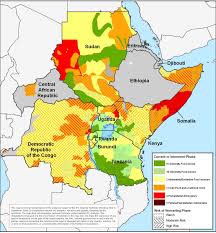Kathmandu | July 14, 2025
From the arid plains of northern Kenya to the highlands of Ethiopia and the rainforests of the Democratic Republic of the Congo, the environmental pulse of Africa's eastern and central belt is under growing strain. Recent developments reveal a troubling convergence of climate-related impacts, invasive species, pollution, and resource degradation - threatening biodiversity, public health, and sustainable livelihoods.
Kenya Battles Invasive Species and Water Woes
In Kenya, two aggressive invasive species are wreaking havoc on the nation’s ecosystems and economy. The spread of Prosopis juliflora, locally known as "mathenge", has overtaken more than two million hectares, especially in arid regions like Samburu. Once promoted as a solution to desertification, the thorny shrub has instead displaced native vegetation, degraded pasturelands, and contaminated groundwater. Simultaneously, water hyacinths have engulfed parts of Lake Naivasha, choking fisheries and drastically reducing fish yields - with local fishermen reporting a drop from 90 kg to as little as 10 kg per day.
Beyond invasive flora, Kenya faces escalating challenges in waste management, deforestation, and shrinking wildlife habitats. Despite these setbacks, conservation efforts - including reforestation and the protection of migratory corridors - offer hope, though funding and enforcement remain inconsistent.
Ethiopia Confronts Deforestation and Climate Disruption
To the north, Ethiopia's environment is being reshaped by soil erosion, highland deforestation, and increasingly erratic weather patterns. Annual soil losses are alarming, threatening food security in already vulnerable regions. While the nation has taken bold steps, including a groundbreaking ban on gasoline and diesel vehicle imports to promote electric mobility, the infrastructure to support such a shift is still in its infancy.
Frequent droughts, particularly in the southern and eastern regions, have led to crop failures and livestock deaths. With a population heavily dependent on agriculture, climate variability is deepening rural poverty and forcing migration toward urban centers.
Congo's Natural Wealth Undermined by Exploitation and Neglect
In the DRC, one of the most biodiverse countries on Earth, environmental threats are accelerating. The vast Congo Basin forests are shrinking due to illegal logging and slash-and-burn agriculture. Artisanal mining, especially for gold and rare minerals, is not only fueling environmental degradation but also contributing significantly to mercury pollution - with an estimated 15 tonnes used annually, contaminating rivers and soils.
Moreover, widespread bushmeat hunting and encroachment into protected areas have put immense pressure on endangered species like gorillas and forest elephants. Only 46% of the population has access to safe drinking water, and poor sanitation exacerbates disease outbreaks, particularly in conflict-affected regions.
A Shared Regional Crisis Demands Collective Action
Despite varying political contexts and resource availability, the three countries share intersecting environmental challenges: unsustainable land use, pollution, biodiversity loss, and climate vulnerability. Yet, opportunities for collaboration exist - from cross-border conservation programs to climate-adaptive agriculture and renewable energy investments.
International organizations, local NGOs, and indigenous communities are calling for urgent, inclusive, and well-funded interventions. Without decisive action, environmental degradation will not only threaten ecosystems but also undermine peace, food security, and regional stability.
Ecosphere News remains committed to amplifying environmental realities from across the globe - bringing attention to both the crises and the courageous efforts to overcome them.
📩 Have a story to share from your region? Email us at [email protected]